Themed collection Spotlight Collection focused on Inorganic Chemistry in Greece

Perovskites with d-block metals for solar energy applications
In this review, we present the most characteristic photoactive perovskites that can be formed with the help of d-block metals.
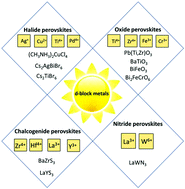
Dalton Trans., 2019,48, 9516-9537
https://doi.org/10.1039/C9DT01485C
2-D spin crossover materials at the nanometric scale: the effects of the size-reduction on the magnetic properties
This minireview summarizes the most important synthetic methodologies for obtaining 2-D FeII SCO particles in the nanometric scale and their SCO magnetic behavior.

Dalton Trans., 2021,50, 3109-3115
https://doi.org/10.1039/D1DT00250C
Observation of two-step spin transition in iron(II) 4-amino-1,2,4-triazole based spin crossover nanoparticles
A synthetically controllable two-step spin transition was observed in iron(II) spin crossover nanoparticles of the dehydrated one-dimensional coordination polymer [Fe(NH2trz)3]Br2 (NH2trz = 4-amino-1,2,4-triazole) using the reverse micellar method.
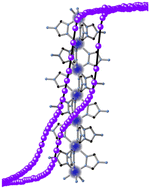
Dalton Trans., 2023,52, 2937-2941
https://doi.org/10.1039/D2DT04118A
Stimuli-responsive spin crossover nanoparticles for drug delivery and DNA-binding studies
Aminated silica hybrid, spin-crossover (SCO) nanoparticles (AmNPs) coupled with (S)-naproxen (NAP) are good candidates for drug nanocarriers.
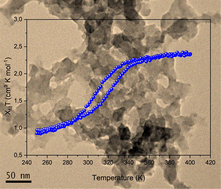
Dalton Trans., 2022,51, 12427-12431
https://doi.org/10.1039/D2DT01509A
A decanuclear [DyIII6ZnII4] cluster: a {ZnII4} rectangle surrounding an octahedral {DyIII6} single molecule magnet
The synthesis, structure and magnetic relaxation properties of a decanuclear [DyIII6ZnII4] complex are reported.
![Graphical abstract: A decanuclear [DyIII6ZnII4] cluster: a {ZnII4} rectangle surrounding an octahedral {DyIII6} single molecule magnet](/en/Image/Get?imageInfo.ImageType=GA&imageInfo.ImageIdentifier.ManuscriptID=C9DT00440H&imageInfo.ImageIdentifier.Year=2019)
Dalton Trans., 2019,48, 3566-3570
https://doi.org/10.1039/C9DT00440H
Heterometallic clusters based on an uncommon asymmetric “V-shaped” [Fe3+(μ-OR)Ln3+(μ-OR)2Fe3+]6+ (Ln = Gd, Tb, Dy, Ho) structural core and the investigation of the slow relaxation of the magnetization behaviour of the [Fe2Dy] analogue
A new family of heterometallic [FeIII2Ln] (Ln = Gd, Tb, Dy, Ho) complexes, possessing an uncommon asymmetric “V-shaped” core and interesting magnetic properties is reported.
![Graphical abstract: Heterometallic clusters based on an uncommon asymmetric “V-shaped” [Fe3+(μ-OR)Ln3+(μ-OR)2Fe3+]6+ (Ln = Gd, Tb, Dy, Ho) structural core and the investigation of the slow relaxation of the magnetization behaviour of the [Fe2Dy] analogue](/en/Image/Get?imageInfo.ImageType=GA&imageInfo.ImageIdentifier.ManuscriptID=D2DT03938A&imageInfo.ImageIdentifier.Year=2023)
Dalton Trans., 2023,52, 6997-7008
https://doi.org/10.1039/D2DT03938A
Synthesis and structural, magnetic and spectroscopic characterization of iron(III) complexes with in situ formed ligands from methyl-2-pyridyl ketone transformations
New [FeIII3] and [FeIII4] complexes with ligands formed in situ from pyCOMe transformations contain both square pyramidal and octahedral metal sites, and display distinct Mössbauer hyperfine parameters.
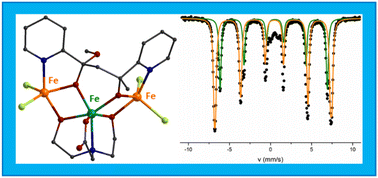
Dalton Trans., 2023,52, 1582-1594
https://doi.org/10.1039/D2DT03944C
Coordination properties of Cu(II) ions towards a phosphorylated fragment from the R1 domain of the tau protein and the effect of Ser phosphorylation on Cu(II) binding affinity
A comparison of the Cu(II) binding affinities of the peptide Ac-GSTENLKH-NH2 and its Ser phosphorylated analogue, belonging to the R1 domain of the tau protein, revealed that the latter is a more effective ligand in acidic media.

Dalton Trans., 2023,52, 58-69
https://doi.org/10.1039/D2DT02838G
A family of mono-, di-, and tetranuclear DyIII complexes bearing the ligand 2,6-diacetylpyridine bis(picolinoylhydrazone) and exhibiting slow relaxation of magnetization
The systematic investigation of the general reaction scheme DyIII/LH2, where LH2 is the organic ligand 2,6-diacetylpyridine bis(picolinoylhydrazone), has led to a family of mono-, di-, and tetranuclear DyIII complexes.
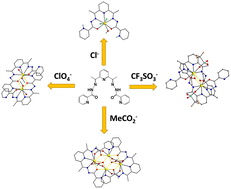
Dalton Trans., 2022,51, 18077-18089
https://doi.org/10.1039/D2DT02921A
Zinc(II) complexes of 3-bromo-5-chloro-salicylaldehyde: characterization and biological activity
Zinc(II) complexes of 3-bromo-5-chloro-salicylaldehyde were isolated, and showed DNA- and albumin-binding affinity and antioxidant and antimicrobial properties.

Dalton Trans., 2022,51, 17629-17641
https://doi.org/10.1039/D2DT02404G
Highly efficient sorption and luminescence sensing of oxoanionic species by 8-connected alkyl-amino functionalized Zr4+ MOFs
Alkylamino-functionalized Zr4+ MOFs with 8-c nets and easily exchangeable terminal OH−/H2O ligands show remarkable sorption efficiency for toxic and radionuclide-related oxoanions and sensing capability for hexavalent chromium in ppb levels.
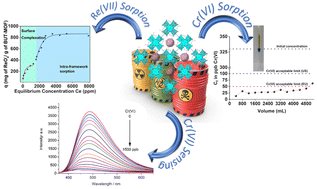
Dalton Trans., 2022,51, 17301-17309
https://doi.org/10.1039/D2DT02848D
Transition metal(II) complexes of halogenated derivatives of (E)-4-(2-(pyridin-2-ylmethylene)hydrazinyl)quinazoline: structure, antioxidant activity, DNA-binding DNA photocleavage, interaction with albumin and in silico studies
Six transition metal(II) complexes with halogenated quinazoline derivatives as ligands were characterized and evaluated for interaction with calf-thymus DNA, photocleavage of plasmid-DNA, affinity for bovine serum albumin, and antioxidant activity.
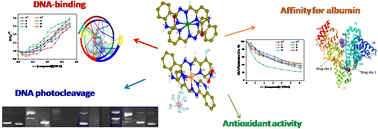
Dalton Trans., 2022,51, 16688-16705
https://doi.org/10.1039/D2DT02622H
Indium(III)/2-benzoylpyridine chemistry: interesting indium(III) bromide-assisted transformations of the ligand
The chemistry of the InX3/2-benzoylpyridine reaction systems (X = Cl, Br) is interesting, including InBr3-assisted reactivity patterns of the coordinated ligand.

Dalton Trans., 2022,51, 15771-15782
https://doi.org/10.1039/D2DT02851D
Sterically demanding pyridine-quinoline anchoring ligands as building blocks for copper(I)-based dye-sensitized solar cell (DSSC) complexes
A nanocrystalline TiO2 dye-sensitized solar cell device consisting of dye 2 and fabricated with commercially available materials reaches a conversion efficiency of η = 1.20%. Dye 2 is a low-cost and easily prepared copper(I) molecular sensitizer.

Dalton Trans., 2022,51, 15049-15066
https://doi.org/10.1039/D2DT02382B
Mononuclear, hexanuclear and polymeric indium(III) pyrazolido complexes; structural characterization, dynamic solution studies and luminescent properties
Mononuclear In(III)-pyrazole complexes with dynamic solution behaviour, were used as starting materials for the synthesis of hexanuclear oxo/hydroxo and clusters and luminescent polymeric pyrazolides.
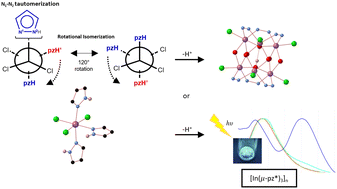
Dalton Trans., 2022,51, 14277-14286
https://doi.org/10.1039/D2DT01901A
Synthesis, characterization, interactions with the DNA duplex dodecamer d(5′-CGCGAATTCGCG-3′)2 and cytotoxicity of binuclear η6-arene-Ru(II) complexes
Novel binuclear organoruthenium complexes were synthesized and characterized, exhibiting significant DNA affinity and promising cytotoxicity.

Dalton Trans., 2022,51, 13808-13825
https://doi.org/10.1039/D2DT02304K
Silver(I) complexes bearing heterocyclic thioamide ligands with NH2 and CF3 substituents: effect of ligand group substitution on antibacterial and anticancer properties
Silver(I) complexes with NH2- and CF3-substituted thioamide ligands were synthesized, with the former exhibiting higher in vitro antibacterial and cytotoxic potency.
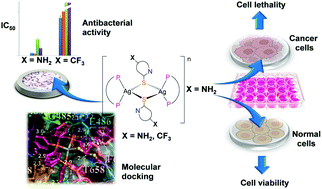
Dalton Trans., 2022,51, 9412-9431
https://doi.org/10.1039/D2DT00793B
Rethinking the molecular structures of WVIOx sites dispersed on titania: distinct mono-oxo configurations at 430 °C and temperature-dependent transformations
The structure of the (WOx)n phase dispersed on TiO2 at surface densities of 0.5–4.5 W nm-2 was explored by in situ Raman and FTIR spectroscopy, 18O/16O exchange and Raman spectroscopy in static equilibrium at temperatures of 175–430 °C.

Dalton Trans., 2022,51, 7455-7475
https://doi.org/10.1039/D2DT00595F
Synthesis, characterization and evaluation of aqueous Zn-based quantum dots for bioapplications
Quantum dots based on Zn like ZnO, ZnSe, ZnS, and doped ZnS : Mn and ZnS : Cd were developed via a simple sol–gel synthesis in an aqueous solution.
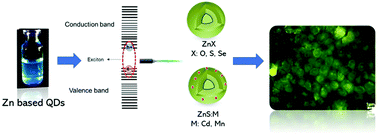
Dalton Trans., 2022,51, 3452-3461
https://doi.org/10.1039/D1DT04021A
Hydrogels containing water soluble conjugates of silver(I) ions with amino acids, metabolites or natural products for non infectious contact lenses
The silver(I) complexes of glycine, urea and salicylic acid were dispersed in poly-hydroxyethyl-methacrylate to form new biomaterials. Their bioactivity makes them efficient candidates for the development of antimicrobial contact lenses.

Dalton Trans., 2021,50, 13712-13727
https://doi.org/10.1039/D1DT02158C
Further synthetic investigation of the general lanthanoid(III) [Ln(III)]/copper(II)/pyridine-2,6-dimethanol/carboxylate reaction system: {CuII5LnIII4} coordination clusters (Ln = Dy, Tb, Ho) and their yttrium(III) analogue
A new family of {Cu5Ln4} complexes bearing the dianionic form of pyridine-2,6-dimethanol (pdm2−) and ancillary ButCH2CO2− carboxylate groups is reported and magnetically studied.
![Graphical abstract: Further synthetic investigation of the general lanthanoid(iii) [Ln(iii)]/copper(ii)/pyridine-2,6-dimethanol/carboxylate reaction system: {CuII5LnIII4} coordination clusters (Ln = Dy, Tb, Ho) and their yttrium(iii) analogue](/en/Image/Get?imageInfo.ImageType=GA&imageInfo.ImageIdentifier.ManuscriptID=D0DT03582C&imageInfo.ImageIdentifier.Year=2021)
Dalton Trans., 2021,50, 240-251
https://doi.org/10.1039/D0DT03582C
Alkaline earth-organic frameworks with amino derivatives of 2,6-naphthalene dicarboxylates: structural studies and fluorescence properties
We present a series of alkaline earth-organic frameworks based on amino-substituted 2,6-naphthalene dicarboxylate bridging ligands featuring infinite rod and rarely observed square planar M4 secondary building units (SBUs).

Dalton Trans., 2020,49, 16736-16744
https://doi.org/10.1039/D0DT03325A
Electrocatalytic hydrogen production by dinuclear cobalt(II) compounds containing redox-active diamidate ligands: a combined experimental and theoretical study
The chiral dicobalt(II) complex [CoII2(μ2-L)2] (1) (H2L = N2,N6-di(quinolin-8-yl)pyridine-2,6-dicarboxamide) and its tert-butyl analogue [CoII2(μ2-LBu)2] (2) were structurally characterized and their catalytic evolution of H2 was investigated.

Dalton Trans., 2020,49, 15718-15730
https://doi.org/10.1039/D0DT02617D
Structurally characterized gallium–chrysin complexes with anticancer potential
Novel, first time crystallographically characterized complexes of Ga(III) with the flavonoid chrysin with cytotoxic and ROS-generating activities.
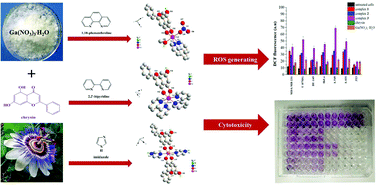
Dalton Trans., 2020,49, 2734-2746
https://doi.org/10.1039/C9DT04540F
Tetranuclear oxido-bridged thorium(IV) clusters obtained using tridentate Schiff bases
The reactions of tetravalent thorium, an element named after the Scandinavian God of thunder and war, with tridentate Schiff bases give tetranuclear complexes with the extremely rare {ThIV4(μ4-O)} unit and interesting properties.
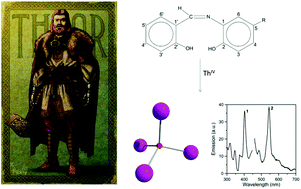
Dalton Trans., 2019,48, 15668-15678
https://doi.org/10.1039/C9DT03189H
{Ni4} Cubanes from enantiomerically pure 2-(1-hydroxyethyl)pyridine ligands: supramolecular chirality
Unprecedented homometallic NiII cubanes have been prepared from chiral ligands. Their structures have been correlated with their magnetic properties.
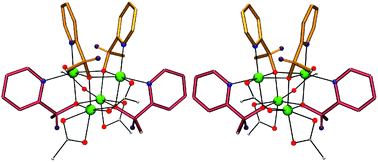
Dalton Trans., 2019,48, 10427-10434
https://doi.org/10.1039/C9DT01026B
Synthesis, structural and physicochemical characterization of a new type Ti6-oxo cluster protected by a cyclic imide dioxime ligand
A new type of Ti6-oxo cluster with a structural motif TiIV6O5 was synthesized of which the cyclo-Ti3 metallic cores exhibit metallaromaticity.
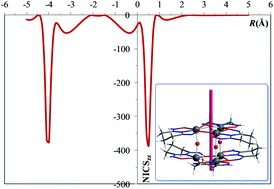
Dalton Trans., 2019,48, 5551-5559
https://doi.org/10.1039/C9DT00658C
Building trans-philicity (trans-effect/trans-influence) ladders for octahedral complexes by using an NMR probe
An NMR trans-philicity ladder was built for octahedral [Cr(CO)5L]−/0/+ complexes employing a 13C NMR probe and quantified by Δσ13C NMR descriptors.

Dalton Trans., 2019,48, 1814-1822
https://doi.org/10.1039/C8DT04562C
About this collection
Inorganic Chemistry in Greece is one of the most popular and fastest growing, interdisciplinary research fields of Chemistry, which is served by an appreciable number of faculty members and Research Directors in all Public Universities and Research Institutes around the country. Along these lines, GReek Inorganic Chemistry community has launched the “1st Panhellenic Workshop on Inorganic Chemistry” (GRIC-2021) to be held in Patras, Greece, on November 19-21, 2021. This is the first Meeting of this kind, which comes as part of our efforts to bring together all active Inorganic Chemistry faculty members and researchers of Universities and Institutes in Greece (and Cyprus), and present, discuss and share our research programs, emerging ideas, and scientific activities towards the establishment of new collaborations, synergies, and consortiums for joint research funding. All information about this Workshop can be found on the website. The research interests of the Greek Inorganic Chemistry community span the areas of synthetic inorganic chemistry (coordination clusters, polymers and MOFs), structural chemistry, materials science, spectroscopic, physicochemical and theoretical characterization, molecule-based magnetism, luminescence, catalysis, conductivity, bioinorganic and medicinal inorganic chemistry, and photochemistry, to name a few. During the GRIC-2021, the recently retired Professors Spyros P. Perlepes (Chemistry Department, University of Patras, Greece) and Themistoklis A. Kabanos (Chemistry Department, University of Ioannina, Greece) will be honored for their significant contributions to the development of Inorganic Chemistry in Greece and their continuous service to the academic community for over 35 years.
This collection is guest edited by Assoc. Prof. Theocharis C. Stamatatos (University of Patras, Greece).